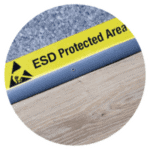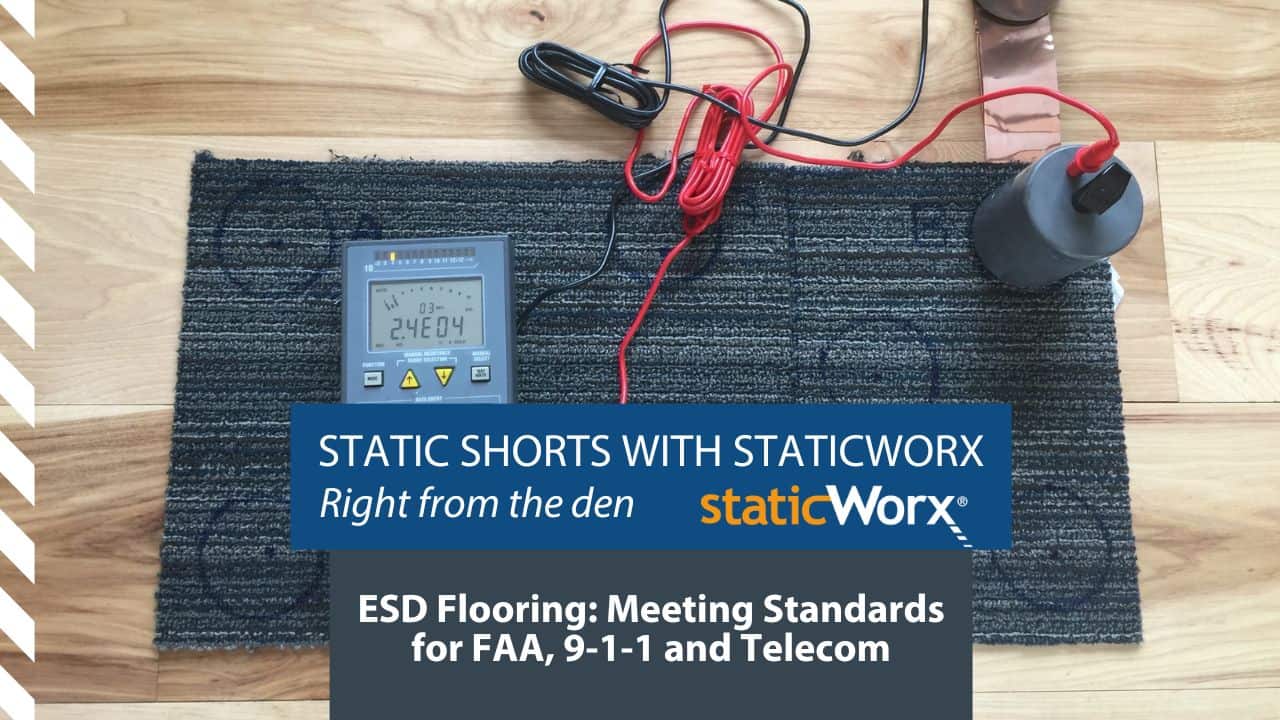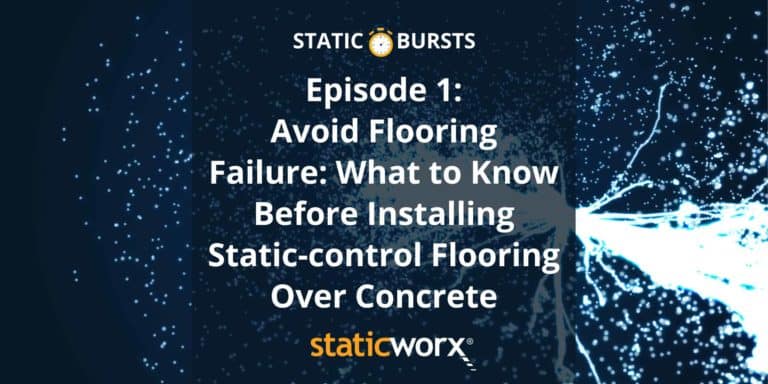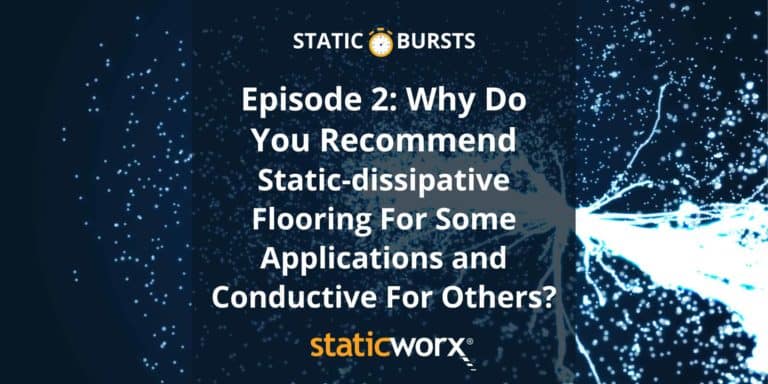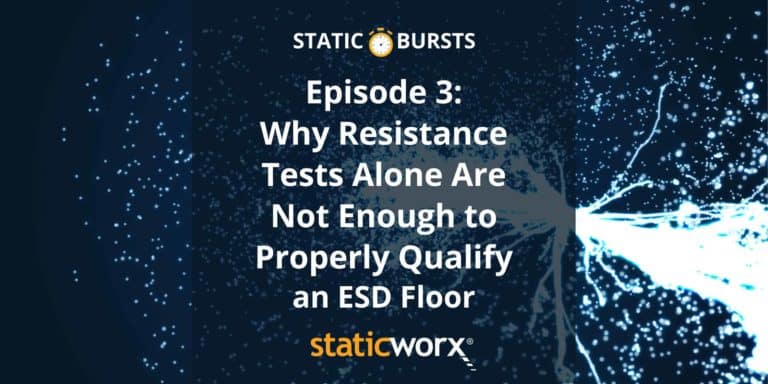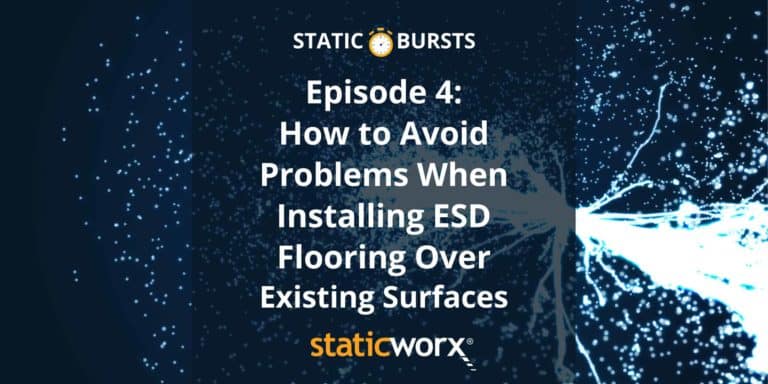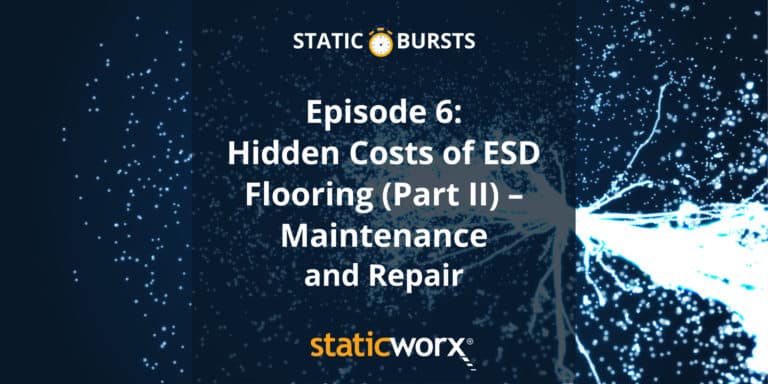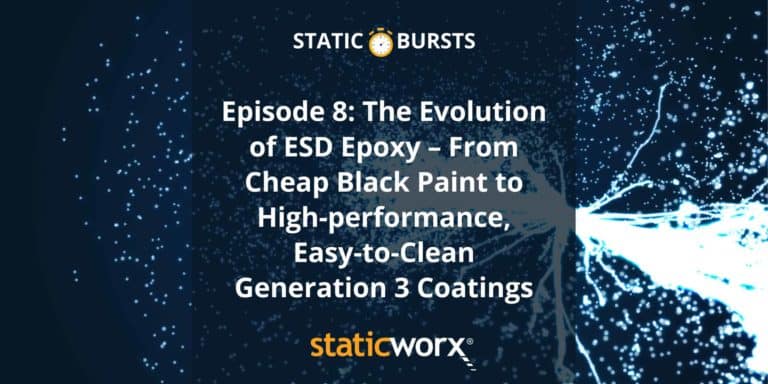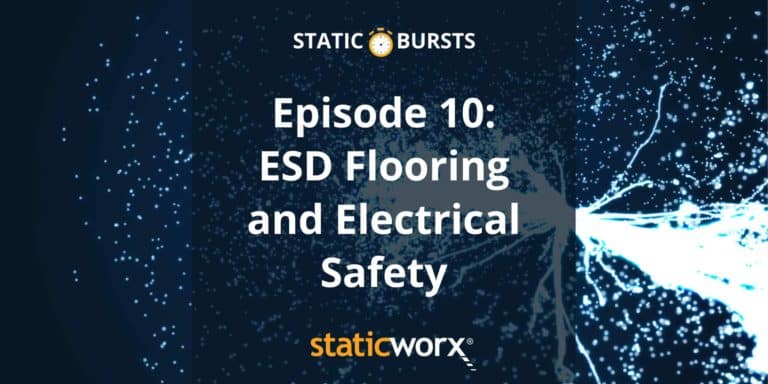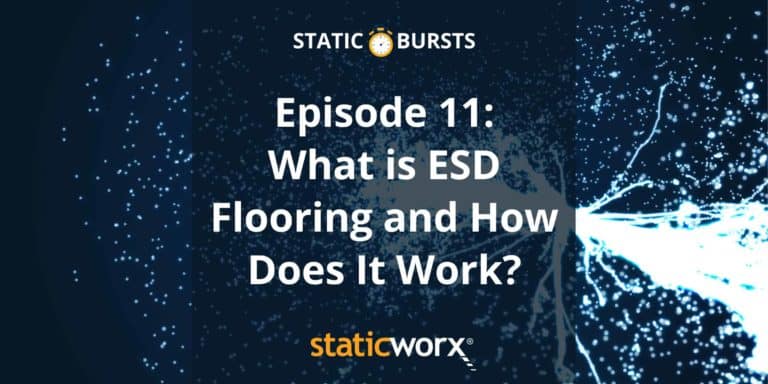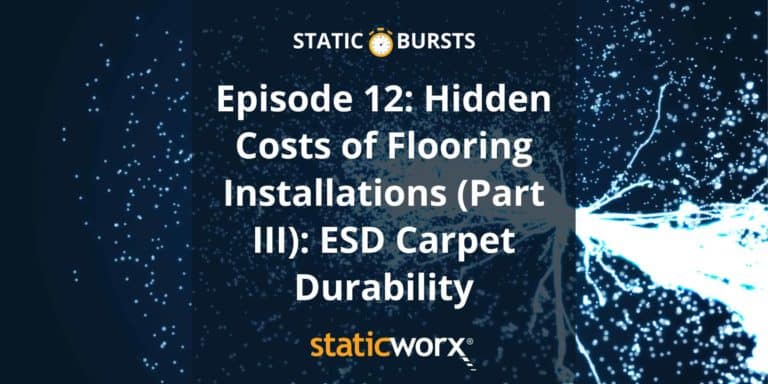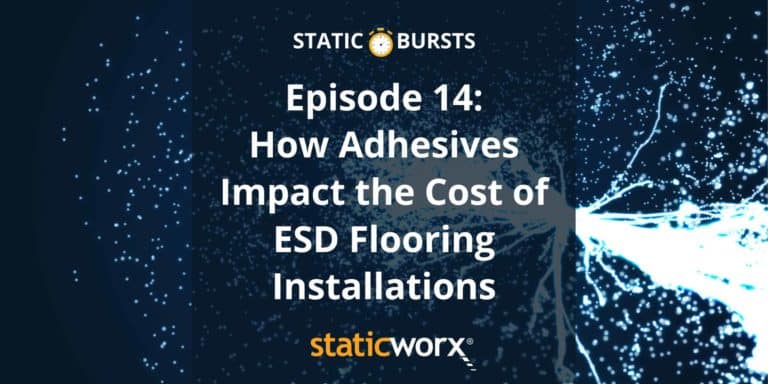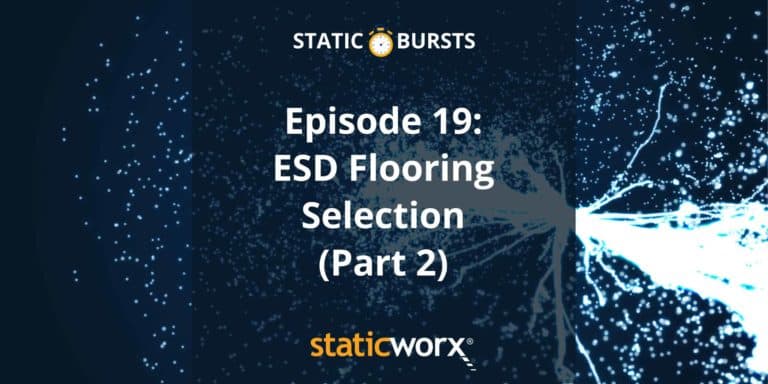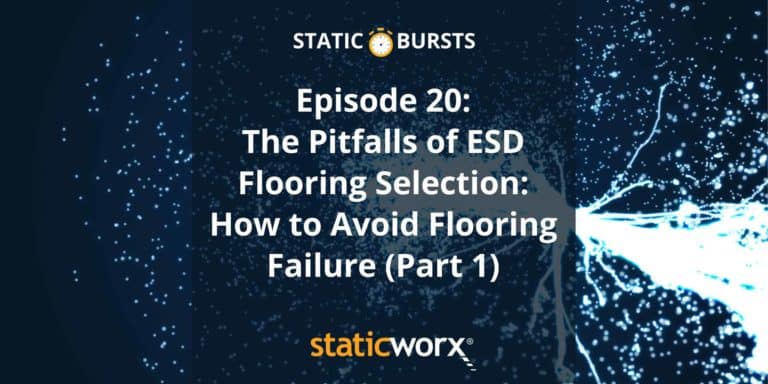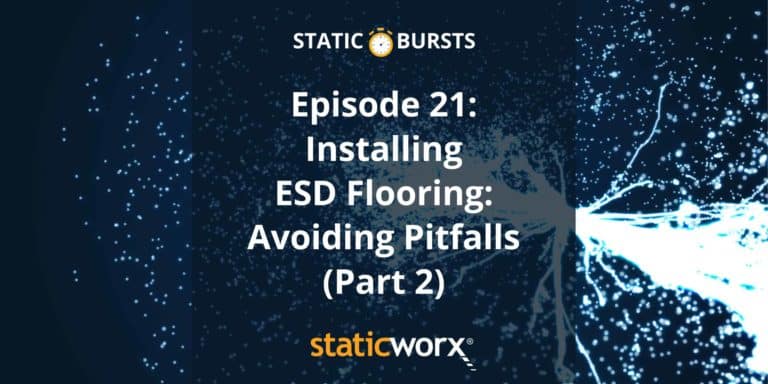Moisture problems are the #1 cause of failed flooring installations. Often the result of aquifers or other environmental conditions, moisture may be invisible. So how do you know if you have a moisture problem? How do you fix the problem? What happens if you choose to ignore moisture readings? If you’re in a 24/7 operational facility, such as a call or data center, a police station, a flight tower or other critical space, how do you solve a moisture problem – adhesive breakdown, for example – without shutting down or compromising your core mission? Dave Long, president of Staticworx, Inc., discusses these and other issues related to mitigating moisture in new construction, renovations, and occupied workspaces.

Static Bursts (Ep #9): How to Write Specifications for Static-Control Flooring
In this three-minute podcast episode, Dave discusses how to write specifications for ESD flooring. Learn why you should never rely solely on technical specifications provided by ESD flooring manufacturers and how properly write specs that comply with industry ESD standards.
The Gist: How to Write Specifications for ESD Flooring
- Do not rely on marketing materials or the ESD flooring manufacturer’s specifications.
- When you write a spec, always look at the international or North American Standard for the material under evaluation.
- Be sure lab tests are done, per the ASTM or ANSI standard for electrical properties.
- Resistance tests should follow guidelines in ANSI/ESD STM 7.1
- Be sure tests are performed in a properly conditioned independent lab.
- After the floor is installed, the manufacturer’s rep should test to be sure it meets the electrical standards outlined in the purchase specifications.
- Standards vary by industry; be sure you follow electrical standards for your industry.
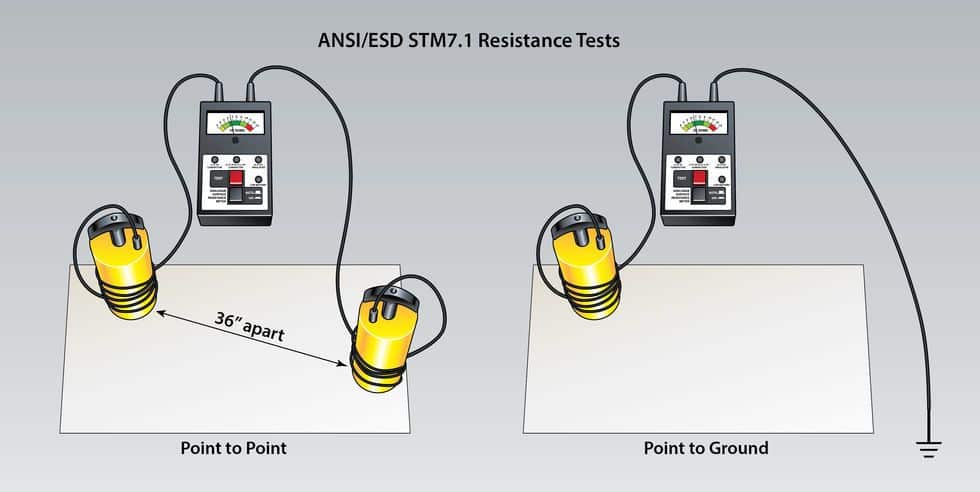
“…if you go back to standards organizations and meet the standards for your industry, you’re home free – because you’re dealing with objective information that can be validated.”
We’ve made it easy to subscribe on your favorite platform!
Dave: Welcome to Static Bursts, an info-packed three-minute podcast from Staticworx, designed for a quick listen. I’m your host, Dave Long, founder and president of Staticworx.
Rick: Dave, could you give our listeners some advice on writing a specification document for static-control flooring?
Dave: When you write a specification, you should always be looking at what is the international or North American Standard for what you’re writing that specification around. You shouldn’t be taking information off of some marketing brochure or rely on the sales lingo that’s used to describe static control floors – literature that is written to help you figure out which one of their products might be more suitable.
So what I’m actually saying is, if there’s an ASTM or an ANSI standard available to describe the electrical properties of a static-control floor, that’s what you should be talking about. So specifications should actually be citing standards organizations; they shouldn’t be citing manufacturers, talking in house lingo. Anytime you write a specification, you should be requiring that lab tests are done using the appropriate resistance test method. It’s called ANSI/ESD STM7.1. You should ask for lab tests that give you the data that was obtained in the lab – hopefully an independent lab because a lot of sales people, and honestly, even flooring manufacturers, don’t have a conditioned lab to do these tests. If they do, that’s fine. But you should be taking that information and putting it into your specification based on the standards I talked about a few minutes ago.
Rick: So anyone specifying static control flooring should refer to the applicable standards documents for their industry and obtain lab testing to confirm that any potential flooring materials are in compliance with those standards.
Should additional testing be done after the floor has been installed?
Dave: If I were writing a spec for a 911 call center, for example, I would actually put in my specification that, upon completion of the flooring installation, the manufacturer or the manufacturer’s representative shall test the floor using an ohm meter per ANSI/ESD STM7.1. And those tests results should be provided in writing. And this should be a commentary on whether or not they met the Motorola R56 standard (for the telecommunications industry).
If it’s a flight tower, resistance readings should meet standard FAA 019f.
If it’s a manufacturing area, the finished installation parameters should match the test data that was provided originally, and should meet ANSI S20.20.
Once again, if you go back to standards organizations and meet the standards for your industry, you’re home free because you’re dealing with objective information that can be validated. There are meters sold on the market that do tests per those standards. And it [following industry standards and testing materials] just keeps everybody on the straight and narrow.
We hope you learned something today. If you have questions about the podcast, give us a call at 617-923-2000. Thanks for listening!
Dave: Welcome to Static Bursts, an info-packed three-minute podcast from Staticworx, designed for a quick listen. I’m your host, Dave Long, founder and president of Staticworx.
Rick: Dave, could you give our listeners some advice on writing a specification document for static-control flooring?
Dave: When you write a specification, you should always be looking at what is the international or North American Standard for what you’re writing that specification around. You shouldn’t be taking information off of some marketing brochure or rely on the sales lingo that’s used to describe static control floors – literature that is written to help you figure out which one of their products might be more suitable.
So what I’m actually saying is, if there’s an ASTM or an ANSI standard available to describe the electrical properties of a static-control floor, that’s what you should be talking about. So specifications should actually be citing standards organizations; they shouldn’t be citing manufacturers, talking in house lingo. Anytime you write a specification, you should be requiring that lab tests are done using the appropriate resistance test method. It’s called ANSI/ESD STM7.1. You should ask for lab tests that give you the data that was obtained in the lab – hopefully an independent lab because a lot of sales people, and honestly, even flooring manufacturers, don’t have a conditioned lab to do these tests. If they do, that’s fine. But you should be taking that information and putting it into your specification based on the standards I talked about a few minutes ago.
Rick: So anyone specifying static control flooring should refer to the applicable standards documents for their industry and obtain lab testing to confirm that any potential flooring materials are in compliance with those standards.
Should additional testing be done after the floor has been installed?
Dave: If I were writing a spec for a 911 call center, for example, I would actually put in my specification that, upon completion of the flooring installation, the manufacturer or the manufacturer’s representative shall test the floor using an ohm meter per ANSI/ESD STM7.1. And those tests results should be provided in writing. And this should be a commentary on whether or not they met the Motorola R56 standard (for the telecommunications industry).
If it’s a flight tower, resistance readings should meet standard FAA 019f.
If it’s a manufacturing area, the finished installation parameters should match the test data that was provided originally, and should meet ANSI S20.20.
Once again, if you go back to standards organizations and meet the standards for your industry, you’re home free because you’re dealing with objective information that can be validated. There are meters sold on the market that do tests per those standards. And it [following industry standards and testing materials] just keeps everybody on the straight and narrow.
We hope you learned something today. If you have questions about the podcast, give us a call at 617-923-2000. Thanks for listening!
Further Reading/Viewing
Get in Touch
The form below will help us better understand your needs and get you as quickly as possible to the right person. We look forward to helping you solve your static problem!
You can expect a response within 24 hours. For faster service, please give us a call: 617-923-2000
"*" indicates required fields
Visit our privacy policy to find out how we process data.
Other Podcast Episodes
Have you ever wondered why we recommend static-dissipative flooring for some applications and conductive for others? Shouldn't both types of flooring work for any application? No, because electrical standards vary by industry.In episode 2 of Static Bursts, Dave and Rick discuss the technical difference between static-dissipative and conductive floors. Standards for flight towers, communications facilities and other end-user applications require flooring with electrical resistance measuring between 1.0 x 10E6 and 1.0 x 10E9. Standards for electronics manufacturing, however, allow for any floor measuring below 1.0 x 10E9. Dave explains why it's important to know and follow industry standards for the specific application where the ESD floor will be installed.
How can you predict whether an ESD flooring material will perform in your workspace? What tests should you do to qualify the floor & why does it matter how the tests are performed? In 2014, ESD standard S20.20 changed to include point-to-point and system resistance tests as well as walking body voltage tests. Learn why these tests matter, what they entail, how to perform the tests properly, and why it’s crucial to evaluate the flooring-footwear combination. Dave Long, president of Staticworx, discusses a process called the Qualification Phase – i.e., the tests that should be performed on flooring materials under consideration, before you select an ESD floor.
New floors are typically installed over the following pre-existing surfaces: VCT (vinyl composition tile), VAT (vinyl asbestos tile), or coatings over concrete. While it is possible and sometimes preferable to install a new floor directly over an old surface, a number of steps should be taken to ensure that the new floor does not fail. The steps including destructive testing to determine whether the bond between the existing surface and subfloor (or existing surfaces) is intact and exactly what lies below the current surface - subfloor? Old tile or coating? Layers of tiles? – as well as testing for asbestos and other regulated chemicals. Dave Long and Rick Frauton discuss situations in which companies have run into trouble, installing new flooring over old, and explain the steps necessary to avoid similar problems.
Moisture or vapor in the concrete subfloor can cause your floor to fail, resulting in serious costs down the line – in some cases, vacating the premises and installing a new floor. People often assume, falsely, that in arid climates, moisture is non-existent. In this episode, Dave and Rick discuss what happens when people fail to do their due diligence (perform moisture tests or ignore readings), and offers advice on how to avoid costly problems.
How do you calculate the actual (full) cost of an ESD floor? Upfront costs for material and installation are only part of the total expenditure. To evaluate the actual, long-term cost of an ESD floor, it’s important to consider the costs of maintenance and repair. In this episode of Static Bursts, Dave and Rick discuss maintenance and repair of ESD epoxy, vinyl, carpet and rubber flooring and what you can expect from each flooring material.
Installing a floor in a 24/7 operational facility comes with its own set of challenges. As with any flooring installation, it’s important to consider logistics: Will chemicals be used? Adhesives? Coatings? Are there toxins or odors to deal with? What is the condition of the current floor or subfloor? Will the old floor require removal? Dave and Rick discuss the optimal way to install an ESD floor in 24/7 operational spaces – without adhesive or chemicals and with neither downtime nor disruption.
ESD Epoxy coatings have evolved over the years to meet the needs of different industries. Generation 1 coatings, consisting of a single layer of black paint, were cheap, easy to repair and ugly. Today’s Generation 3 epoxy coatings are attractive, easy to install and repair, and offer significant improvements in ESD performance. In this podcast, Dave and Rick discuss the history and evolution of ESD epoxy coatings – from their introduction in the 1950s, through improvements in Gen 2 coatings, to the high-performance Gen 3 coatings available today.
In this episode, Dave and Rick discuss ESD floors and electrical safety. At some point when discussing grounded conductive floors, the question of safety always arises, along with whether or not grounding a conductive floor puts people in harm’s way. Referring to an actual case study, Dave talks about a situation in which a floor installed for the FAA was too conductive to meet the FAA safety standards. The client had been told that drying the pressure-sensitive adhesive would solve the problem, making the entire floor less conductive. Dave talks about why this is not true, and why it’s extremely important to adhere to electrical standards as they are written.
ESD flooring is a generic term. In this episode, Dave and Rick discuss what people mean by ESD flooring. Dave provides a basic tutorial on how ESD floors work, and why – rather than relying on a manufacturer’s spec sheet - it’s crucial to test the electrical properties of any ESD floor under consideration.
ESD carpet can be an ideal floor for many different spaces, particularly for critical 24/7 operations where a soft walking surface and/or sound attenuation is necessary or desired. Carpet is also attractive and, compared to certain higher-cost materials, reasonably priced. There are, however, hidden costs buyers should be aware of before selecting ESD carpeting. In this podcast, Dave and Rick discuss the reasons carpet construction, fiber geometry, modification ratio and carpet design are crucial for understanding the real cost of ESD carpet.
In this short 3-minute podcast episode, Dave and Rick talk about why no single type of ESD flooring material is suitable for every application. Flooring materials like ESD vinyl must be used in conjunction with special ESD footwear. Those materials are unsuitable for facilities in which personnel wear regular street shoes. In spaces where street shoes are allowed – data centers, 9-1-1 call centers and government offices, for instance – the ESD floor must dissipate static to ground and also inhibit static generation in the first place.
Three types of conductive adhesives are typically used to install ESD floors: epoxy, acrylic, and pressure-sensitive. Each adhesive has advantages and disadvantages. Dave explains the differences, details pros and cons, and discusses why – and in what circumstances – one adhesive might be preferable over another. The fourth option is to choose a glue-free installation, such as interlocking ESD tiles. Interlocking tiles are chemical-free, have no fumes or mess, and can be installed in a functional workspace without disrupting operations.
Properly qualifying an ESD floor requires more than testing for electrical resistance. We used to believe that the conductivity of a floor predicted its potential for static charge generation. We now know that resistance and charge generation are independent qualities: one does not relate to the other. A floor can be conductive and still generate static electricity. We also know that flooring materials perform differently with different types of footwear. In this episode, Dave and Rick discuss why it’s important to test the floor as part of an integrated ESD flooring/footwear system – and to test for both conductivity and charge generation.
In this episode, Dave and Rick explain how ESD chairs work and why they act as a bridge between two perfect methods of grounding (an ESD floor and wrist strap). The ESD floor grounds and prevents charge generation while people walk. Once the person sits and lifts his or her feet, they are no longer grounded. There may be a wrist strap at the work station, but until the person puts it on they’re a live wire. If they touch a component – or expensive prototype, for example – before putting on the wrist strap, any charge on their body will transfer to the component. ESD chairs ground the person in the chair, prevent charge generation and protecting against random ESD events.
StaticWorx was asked to evaluate a failing floor in an electronics manufacturing facility. After a fire the client had purchased a new ESD vinyl tile floor. Three months into the installation the floor was already lifting. In addition to unmitigated vapor, the building had been built using tilt-up construction. Silicone bond-breakers - sprayed on the concrete to keep the wall slabs from adhering to the subfloor - contaminated the concrete, preventing the tile from adhering properly. As the building was operational and the client wanted to avoid shutdown, Dave recommended interlocking ESD vinyl tile. StaticWorx installed a 10’ x 10’ test patch. Two months later, the interlocking floor was intact. StaticWorx covered the entire floor in the operational facility with interlocking vinyl tile - without the client’s losing a day of production.
Most people looking to purchase an ESD floor are starting at ground zero, with little knowledge about the product. In this two part series, Dave and Rick discuss the key criteria for selecting an ESD floor. Part one covers the application (environment and work performed in the space); aesthetics; installation methods; and maintenance requirements.
When choosing an ESD floor, it’s important to consider all the variables related to your specific application. Will you roll heavy loads on the floor? Do you need noise attenuation, anti-fatigue characteristics, or reflectivity? How long do you plan to stay in the building? When evaluating options, remember that the cost per square foot is only one part of the total cost of owning the floor. Installation, labor, maintenance, operational downtime add up – in the short term as well as over time.
Three fundamental mistakes account for a majority of ESD flooring failures: selecting the wrong floor for the application: failure to consider total cost of ownership; failing to test the floor after it’s been installed. Avoiding these mistakes helps ensure success. This first of a two-part series on avoiding ESD flooring failures explains why it’s important to select a floor based on the specific application and details the primary considerations that should be taken into account: assessing the type of footwear people will wear in the space and considering goals and objectives, including how the space will be used.
The cost of flooring materials is only part of the total cost of ownership. To calculate the long-term cost of owning a floor, consider installation, maintenance, repairs, and downtime required for maintenance and repair. Aesthetics are another consideration. this podcast, Dave and Rick describe scenarios that occur when people base flooring decisions solely on the cost of the material. Dave also explains why it’s crucial to test an ESD floor immediately after it’s been installed.
Learning Center Articles
- ESD Basics
- Installation & Maintenance
- Selecting & Specifying an ESD Floor
- Technical Information
- 7 Common Mistakes Selecting an ESD floor
- A Guide to ESD Flooring Selection
- Avoid Costly Failures: What You Need to Know When Specifying ESD Flooring
- Choosing ESD Flooring for:
- ESD Footwear: What Is It and When Is It Necessary?
- ESD Footwear for Electronics Manufacturing and Handling Applications
- Facility Managers’ Guide to Selecting ESD Flooring
- The Need for Due Diligence in Specifying Static-Free Flooring
- Standard of Care for Specifying Floors in Mission-Critical Spaces
- Understanding the Hidden Costs of ESD Flooring

StaticWorx high-performance static-control floors protect electronic components, explosives, and high-speed computers from damage caused by static electricity. ESD flooring is part of a system. Choices should always be based on objective, researched evidence. When you partner with us, we look at all possible items that may need to integrate with the floor, and, focusing on your goals and objectives, help you find the right floor for your application.



